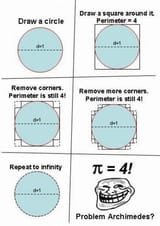>>16827336
>post-multi var calculus
When was that developed?
Are you saying mathematicians prior to its development would have seen the proof in OP or something like it and concluded pi=4 etc? (maybe not for this particular example, because you can physically measure a real-world circle with some string and get a better value, but for some other shape or related concept)
Because the line gets closer and closer to the circle, just like mathematicians do with polygons in circles to find the true value of Pi, or with integration for the area under a curve.
In fact, this looks a lot like the area under a curve, except that it is length rather than area.
Are there examples of simple "proofs" that were widely held, later to be shown false?
And is the "post-multi var calculus" explanation applied "organically", as in it would crop up as a natural explanation for why OP's proof does not work, or is it applicable because we know OP is wrong ex post facto?























